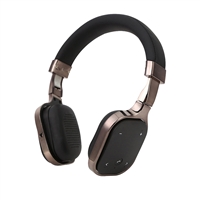
The size, type, and technology of a pair of headphones are all critical to a purchasing decision. But it is important to demystify the bevy of features and headphone-specific vocabulary. Listed below are the most important features you will need to consider before finding the perfect pair of headphones. ...
The size, type, and technology of a pair of headphones are all critical to a purchasing decision. But it's important to demystify the bevy of features and headphone-specific vocabulary. Listed below are the most important features you'll need to consider before finding the perfect pair of headphones.
Bass: Even at its very best, headphone bass is never the sort of pants-flapping, sock-it-to-your-gut experience you literally feel from massive speakers or subwoofers, but many manufacturers (like the Beats by Dr. Dre) custom tune their "signature sound" to emphasize the lower frequencies, albeit at the cost of instrument separation and natural delivery.
Earbuds are tiny and portable, but -- except for a couple of high-end models -- they can't compete with full-size, over-the-ear headphones for deep bass response or visceral dynamic range.
Sealed vs. open: Sealed headphones -- the noise-isolating, in-ear models or the full-size earcup designs -- acoustically isolate your ears from your environment. Of course, the degree of isolation varies from one pair of headphones to another, and the seal limits the leakage of the headphones' sound out to the room.
Sealed models are ideal for private listening, where you don't want the sound to be heard by other people. Open headphones -- such as foam earpad models and many sports designs -- are acoustically transparent and allow outside sound to be heard by the headphone wearer, and a good deal of the headphones' sound will be audible to anyone near the listener.
Generally speaking, such headphones produce better, more "open" sound than sealed designs. Because they don't block out everything from the outside world, open-backed headphones are recommended for outdoor activities, such as jogging, which require awareness of your environment.
Comfort and weight: Assessing sound quality is always a subjective exercise, but the only way to judge comfort is to put them on and listen for at least 10 minutes.
Do the earpads exert too much pressure on your ears? Headphones that enclose or cover your ears can get uncomfortably hot, but you'll have to wear them for a while to find out. Some of the bigger sealed models with cushy leatherette pads are the worst offenders.
Pro-style headphones are comparatively bulky and can feel uncomfortably heavy after hours of use. Lighter headband-style headphones are almost always more comfortable than heavier ones. And even if they're not, they're less of a hassle to carry around.
Durability: There's no reason a headphone should be treated as disposable technology. Unlike almost everything else in the realm of consumer electronics, this year's headphones won't be obsolete six months or a year from now. In fact, there's no reason a good pair of headphones can't last for the better part of a decade.
Be sure to assess the build quality of your prospective headphones. Some earbuds and portable devices are relatively fragile, for instance. If the headphones fold up for easy storage, are the hinges robust, or will they fall apart in a month or two? Don't forge to consider that the earpads and earbuds will get extensive wear and tear over the life of the headphones.
Cable dressing and length: Most stereo headphones have just one cable, usually attached to the left earpiece (sometimes called single-sided cabling). Some models -- and all earbuds -- use a Y-cable that connects to both earpieces (double-sided). The actual cable plug, meanwhile, is usually one of two designs: a straight I-plug or an angled L-plug; the latter may be useful if your portable player has a side- or bottom-mounted headphone jack.
Preferences for the length of headphone cables vary for portable users, especially depending on where you prefer to wear your device: a backpack or a pants pocket necessitates a longer cable, while you'll opt for a short one when wearing a player on a neck lavalier or an armband. But a cable length at either extreme need not be a fatal flaw: extension cables can lengthen those that are too short, and cable wraps can tighten up ones that are too long.
Customer Service
